 полная версия
полная версияStory of the Bible Animals
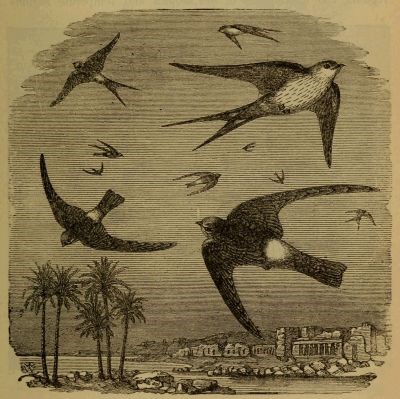
THE SWALLOW AND SWIFT.
Under these favourable conditions, therefore, the number of species which are found in Palestine is perhaps greater than can be seen in any other part of the earth of the same dimensions, and it seems probable that for this reason, among many others, Palestine was selected to be the Holy Land. If, for example, the Christian Church had been originated under the tropics, those who lived in a cold climate could scarcely have understood the language in which the Scriptures must necessarily have been couched. Had it, on the contrary, taken its rise in the Arctic regions, the inhabitants of the tropics and temperate regions could not have comprehended the imagery in which the teachings of Scripture must have been conveyed. But the small and geographically insignificant Land of Palestine combines in itself many of the characteristics which belong respectively to the cold, the temperate, and the hot regions of the world, so that the terms in which the sacred writings are couched are intelligible to a very great proportion of the world's inhabitants.

VIEW OF THE SEA OF GALILEE.
This being the case, we naturally expect to find that several species of the Swallow are inhabitants of Palestine, if so migratory a bird can be said to be an inhabitant of any one country.
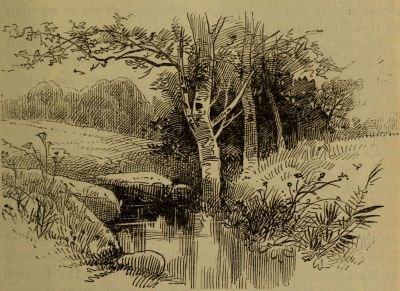
THE SWALLOW'S FAVOURITE HAUNT.
The chief characteristic of the Swallow, the "bird of freedom," is that it cannot endure captivity, but is forced by instinct to pass from one country to another for the purpose of preserving itself in a tolerably equable temperature, moving northwards as the spring ripens into summer, and southwards as autumn begins to sink into winter. By some marvellous instinct it traces its way over vast distances, passing over hundreds of miles where nothing but the sea is beneath it, and yet at the appointed season returning with unerring certainty to the spot where it was hatched. How it is guided no one knows, but the fact is certain, that Swallows, remarkable for some peculiarity by which they could be at once identified, have been observed to leave the country on their migration, and to return in the following year to the identical nest whence they started.
Its habit of making its nest among the habitations of mankind is mentioned in a well-known passage of the Psalms: "The sparrow hath found an house, and the swallow a nest for herself, where she may lay her young, even Thine altars, O Lord of Hosts, my King and my God" (Ps. lxxxiv. 3). The Swallow seems in all countries to have enjoyed the protection of man, and to have been suffered to build in peace under his roof. We find the same idea prevalent in the New World as well as the Old, and it is rather curious that the presence of the bird should so generally be thought to bring luck to a house.
In some parts of our country, a farmer would not dare to kill a Swallow or break down its nest, simply because he thinks that if he did so his cows would fail to give their due supply of milk. The connexion between the milking of a cow in the field and the destruction of a Swallow's nest in the house is not very easy to see, but nevertheless such is the belief. This idea ranks with that which asserts the robin and the wren to be the male and female of the same species, and to be under some special divine protection.
Whatever may be the origin of this superstition, whether it be derived from some forgotten source, or whether it be the natural result of the confiding nature of the bird, the Swallow enjoys at the present day the protection of man, and builds freely in his houses, and even his places of worship. The heathen temples, the Mahometan mosques, and the Christian churches are alike inhabited by the Swallow, who seems to know her security, and often places her nest where a child might reach it.
The bird does not, however, restrict itself to the habitations of man, though it prefers them; and in those places where no houses are to be found, and yet where insects are plentiful, it takes possession of the clefts of rocks, and therein makes its nest. Many instances are known where the Swallow has chosen the most extraordinary places for its nest. It has been known to build year after year on the frame of a picture, between the handles of a pair of shears hung on the wall, on a lamp-bracket, in a table-drawer, on a door-knocker, and similar strange localities.
The swiftness of flight for which this bird is remarkable is noticed by the sacred writers. "As the bird by wandering, as the swallow by flying, so the curse causeless shall not come" (Prov. xxvi. 2). This passage is given rather differently in the Jewish Bible, though the general sense remains the same: "As the bird is ready to flee, as the swallow to fly away; so a causeless execration, it shall not come." It is possible, however, that this passage may allude rather to the migration than the swiftness of the bird.
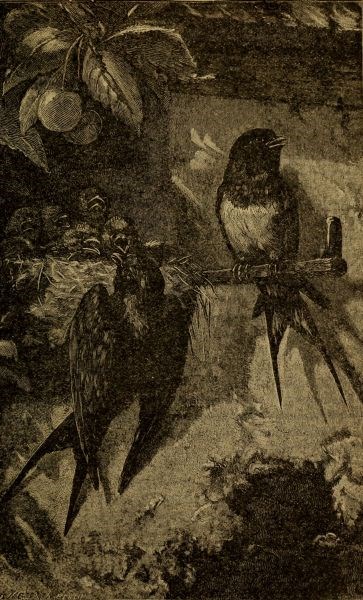
SWALLOWS AT HOME.
THE HOOPOE, OR LAPWING OF SCRIPTURE
The "Dukiphath" of Scripture—Various interpretations of the word—The Hoopoe—Its beauty and ill reputation—The unpleasant odour of its nest—Food of the Hoopoe—Its beautiful nest, and remarkable gestures—A curious legend of Solomon and the Hoopoe.
In the two parallel chapters, Lev. xi. and Deut. xiv., there occurs the name of a bird which is translated in the Authorized Version, Lapwing: "And the stork, the heron after her kind, the lapwing, and the bat."
The Hebrew word is dukiphath, and various interpretations have been proposed for it, some taking it to be the common domestic fowl, others the cock-of-the-woods, or capercailzie, while others have preferred to translate it as Hoopoe. The Jewish Bible retains the word lapwing, but adds the mark of doubt. Commentators are, however, agreed that of all these interpretations, that which renders the word as Hoopoe (Upupa epops) is the best.
There would be no particular object in the prohibition of such a bird as the lapwing, or any of its kin, while there would be very good reasons for the same injunction with regard to the Hoopoe.
In spite of the beauty of the bird, it has always had rather an ill reputation, and, whether in Europe or Asia, its presence seems to be regarded by the ignorant with a kind of superstitious aversion. This universal distaste for the Hoopoe is probably occasioned by an exceedingly pungent and disagreeable odour which fills the nest of the bird, and which infects for a considerable time the hand which is employed to take the eggs.
The nest is, moreover, well calculated for retaining any unpleasant smell, being generally made in the hollow of a tree, and having therefore but little of that thorough ventilation which is found in nearly all nests which are built on boughs and sprays.
The food of the Hoopoe consists almost entirely of insects They have been said to feed on earth-worms; but this notion seems to be a mistaken one, as in captivity they will not touch an earth-worm so long as they can procure an insect. Beetles of various kinds seem to be their favourite food, and when the beetles are tolerably large—say, for example, as large as the common cockchafer and dor-beetle—the bird beats them into a soft mass before it attempts to eat them. Smaller beetles are swallowed without any ceremony. The various boring insects which make their home in decaying wood are favourite articles of diet with the Hoopoe, which digs them out of the soft wood with its long curved beak.
It has already been mentioned that the nest is usually made in the hollow of a tree. In many parts of the country however, hollow trees cannot be found, and in that case the Hoopoe resorts to clefts in the rock, or even to holes in old ruins.
The bird is a peculiarly conspicuous one, not only on account of its boldly-barred plumage and its beautiful crest, but by its cry and its gestures. It has a way of elevating and depressing its crest, and bobbing its head up and down, in a manner which could not fail to attract the attention even of the most incurious, the whole aspect and expression of the bird varying with the raising and depressing of the crest.
Respecting this crest there is a curious old legend. As is the case with most of the Oriental legends, it introduces the name of King Solomon, who, according to Oriental notions, was a mighty wizard rather than a wise king, and by means of his seal, on which was engraven the mystic symbol of Divinity, held sway over the birds, the beasts, the elements, and even over the Jinns and Afreets, i.e. the good and evil spirits, which are too ethereal for the material world and too gross for the spiritual, and therefore hold the middle place between them.
On one of his journeys across the desert, Solomon was perishing from the heat of the sun, when the Hoopoes came to his aid, and flew in a dense mass over his head, thus forming a shelter from the fiery sunbeams. Grateful for this assistance, the monarch told the Hoopoes to ask for a boon, and it should be granted to them. The birds, after consulting together, agreed to ask that from that time every Hoopoe should wear a crown of gold like Solomon himself. The request was immediately granted, and each Hoopoe found itself adorned with a royal crown. At first, while their honours were new, great was the joy of the birds, who paused at every little puddle of water to contemplate themselves, bowing their heads over the watery mirror so as to display the crown to the best advantage.
Soon, however, they found cause to repent of their ambition. The golden crown became heavy and wearisome to them, and, besides, the wealth bestowed on the birds rendered them the prey of every fowler. The unfortunate Hoopoes were persecuted in all directions for the sake of their golden crowns which they could neither take off nor conceal.
At last, the few survivors presented themselves before Solomon, and begged him to rescind his fatal gift, which he did by substituting a crest of feathers for the crown of gold. The Hoopoe, however, never forgets its former grandeur, and is always bowing and bending itself as it used to do when contemplating its golden crown in the water.
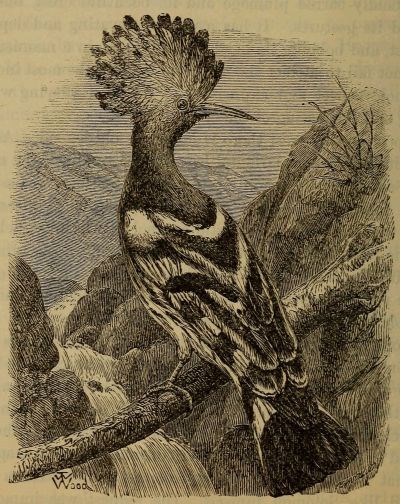

EASTERN HOUSE-TOP.
THE SPARROW
The Sparrow upon the house top—Architecture of the East—Little birds exposed for sale in the market—The two Sparrows sold for a farthing—Bird-catching—The net, the snare, and the trap.
We have already discussed the signification of the compound word tzippor-deror, and will now take the word tzippor alone.
Like many other Hebrew terms, the word is evidently used in a collective sense, signifying any small bird that is not specially designated. In several portions of Scripture it is translated as Sparrow, and to that word we will at present restrict ourselves.
On turning to Ps. cii. 5-7, we find that the word is used as an emblem of solitude and misery: "By reason of the voice of my groaning, my bones cleave to my skin.
"I am like a pelican of the wilderness: I am like an owl of the desert,
"I watch, and am as a sparrow alone upon the house-top."
The word which is here translated as "Sparrow" is tzippor, the same which is rendered as "bird" in Lev. xiv. 4. The Hebrew Bible more consistently uses the collective term "bird" in both instances, and renders the passage as, "I watch, and am as a lonely bird upon a roof."
Now, any one who knows the habits of the Sparrow is perfectly aware that it is a peculiarly sociable bird. It is quarrelsome enough with its fellows, and always ready to fight for a stray grain or morsel of food; but it is exceedingly gregarious, assembling together in little parties, enlivening the air with its merry though unmusical twitterings.
This cosmopolitan bird is plentiful in the coast towns of Palestine, where it haunts the habitations of men with the same dauntless confidence which it displays in this country. It is often seen upon roofs or house-tops, but is no more apt to sit alone in Palestine than it is here. On the contrary, the Sparrows collect in great numbers on the house-tops, attracted by the abundant supply of food which it finds there. This requires some little explanation.
The house-tops of the East, instead of being gabled and tiled as among ourselves, to allow the rain to run off, are quite flat, and serve as terraces or promenades in the evening, or even for sleeping-places; and from the house-tops proclamations were made. See, for example, 1 Sam. ix. 25: "And when they were come down from the high place into the city, Samuel communed with Saul upon the top of the house"—this being the ordinary place which would be chosen for a conversation. In order to keep out the heat of the mid-day sun, tents were sometimes pitched upon these flat house-tops. (See 2 Sam. xvi. 22.) Reference to the use of the house-tops as places for conversation are made in the New Testament. See, for example, Matt. x. 27: "What I tell you in darkness, that speak ye in light; and what ye hear in the ear, that preach ye upon the house-tops." Another passage of a similar nature occurs in Luke xii. 3: "Therefore whatsoever ye have spoken in darkness shall be heard in the light, and that which ye have spoken in the ear in closets shall be proclaimed on the house-tops."
These roofs, instead of being built with sloping rafters like those to which we are accustomed in this country, are made with great beams of wood laid horizontally, and crossed by planks, poles, and brushwood packed tightly together. As this roof would not keep out the rain, it is covered with a thick layer of clay mixed with straw, and beaten down as hard as possible. This covering has constantly to be renewed, as, even in the best made roofs, the heavy rains are sure to wash away some portion of the clay covering, which has to be patched up with a fresh supply of earth. A stone roller is generally kept on the roof of each house for the purpose of making a flat and even surface.
The earth which is used for this purpose is brought from the uncultivated ground, and is full of various seeds. As soon as the rains fall, these seeds spring up, and afford food to the Sparrows and other little birds, who assemble in thousands on the house-tops, and then peck away just as they do in our own streets and farm-yards.
It is now evident that the "sparrow alone and melancholy upon the house-tops" cannot be the lively, gregarious Sparrow which assembles in such numbers on these favourite feeding-places. We must therefore look for some other bird, and naturalists are now agreed that we may accept the Blue Thrush (Petrocossyphus cyaneus) as the particular Tzippor, or small bird, which sits alone on the house-tops.
The colour of this bird is a dark blue, whence it derives its popular name. Its habits exactly correspond with the idea of solitude and melancholy. The Blue Thrushes never assemble in flocks, and it is very rare to see more than a pair together. It is fond of sitting on the tops of houses, uttering its note, which, however agreeable to itself, is monotonous and melancholy to a human ear.
In connexion with the passage already quoted, "What ye hear in the ear, that preach ye upon the house-tops," I will take the opportunity of explaining the passage itself, which scarcely seems relevant to the occasion unless we understand its bearings. The context shows that our Lord was speaking of the new doctrines which He had come to teach, and the duty of spreading them, and alludes to a mode of religious teaching which was then in vogue.
The long captivity of the Jews in Babylon had caused the Hebrew language to be disused among the common people, who had learned the Chaldaic language from their captors. After their return to Palestine, the custom of publicly reading the Scriptures was found to be positively useless, the generality of the people being ignorant of the Hebrew language.
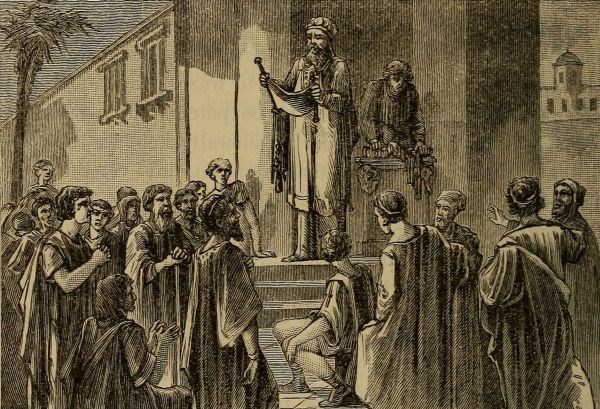
READING THE LAW TO THE PEOPLE AFTER THE RETURN FROM CAPTIVITY.
Accordingly, the following modification was adopted. The roll of the Scriptures was brought out as usual, and the sacred words read, or rather chanted. After each passage was read, a doctor of the law whispered its meaning into the ear of a Targumista or interpreter, who repeated to the people in the Chaldaic language the explanation which the doctor had whispered in Hebrew. The reader will now see how appropriate is the metaphor, the whispering in the ear and subsequent proclamation being the customary mode of imparting religious instruction.
If the reader will now turn to Matt. x. 29, he will find that the word "sparrow" is used in a passage which has become very familiar to us. "Are not two sparrows sold for a farthing? and one of them shall not fall on the ground without your Father.
"But the very hairs of your head are all numbered.
"Fear ye not therefore, ye are of more value than many sparrows." The same sentences are given by St. Luke (xii. 6), in almost the same words.

THE BLUE THRUSH, OR SPARROW OF SCRIPTURE.
Now the word which is translated as "Sparrow" is strouthion, a collective word, signifying a bird of any kind. Without the addition of some epithet, it was generally used to signify any kind of small bird, though it is occasionally employed to signify even so large a creature as an eagle, provided that the bird had been mentioned beforehand. Conjoined with the word "great," it signifies the ostrich; and when used in connexion with a word significative of running, it is employed as a general term for all cursorial birds.
In the passages above quoted it is used alone, and evidently signifies any kind of little bird, whether it be a sparrow or not. Allusion is made by our Lord to a custom, which has survived to the present day, of exposing for sale in the markets the bodies of little birds. They are stripped of their feathers, and spitted together in rows, and always have a large sale.
Various birds are sold in this manner, little if any distinction being made between them, save perhaps in respect of size, the larger species commanding a higher price than the small birds. In fact, they are arranged exactly after the manner in which the Orientals sell their "kabobs," i.e. little pieces of meat pierced by wooden skewers.
It is evident that to supply such a market it is necessary that the birds should be of a tolerably gregarious nature, so that a considerable number can be caught at a time. Nets were employed for this purpose, and we may safely infer that the forms of the nets and the methods of using them were identical with those which are employed in the same country at the present day.
The fowlers supply themselves with a large net supported on two sticks, and, taking a lantern with them fastened to the top of a pole, they sally out at night to the places where the small birds sleep.
Raising the net on its sticks, they lift it to the requisite height, and hold the lantern exactly opposite to it, so as to place the net between the birds and the lantern. The roosting-places are then beaten with sticks or pelted with stones, so as to awaken the sleeping birds. Startled by the sudden noise, they dash from their roosts, instinctively make towards the light, and so fall into the net. Bird-catching with nets is several times mentioned in the Old Testament, but in the New the net is only alluded to as used for taking fish.
Beside the net, several other modes of bird-catching were used by the ancient Jews, just as is the case at the present day. Boys, for example, who catch birds for their own consumption, and not for the market, can do so by means of various traps, most of which are made on the principle of the noose, or snare. Sometimes a great number of hair-nooses are set in places to which the birds are decoyed, so that in hopping about many of them are sure to become entangled in the snares. Sometimes the noose is ingeniously suspended in a narrow passage which the birds are likely to traverse, and sometimes a simple fall-trap is employed.
We now pass to another division of the subject. In Ps. lxxxiv. 1-3, we come upon a passage in which the Sparrow is again mentioned: "How amiable are Thy tabernacles, O Lord of hosts!
"My soul longeth, yea, even fainteth for the courts of the Lord; my heart and my flesh crieth out for the living God.
"Yea, the sparrow hath found an house, and the swallow a nest for herself, where she may lay her young, even Thine altars, O Lord of hosts, my King, and my God."

THE TREE-SPARROW, OR SPARROW OF SCRIPTURE.
It is evident that we have in this passage a different bird from the Sparrow that sitteth alone upon the house-tops; and though the same word, tzippor, is used in both cases, it is clear that whereas the former bird was mentioned as an emblem of sorrow, solitude, and sadness, the latter is brought forward as an image of joy and happiness. "Blessed are they," proceeds the Psalmist, "that dwell in Thy house: they will be still praising Thee.... For a day in Thy courts is better than a thousand. I had rather be a doorkeeper in the house of my God, than to dwell in the tents of wickedness."
According to Mr. Tristram, this is probably one of the species to which allusion is made by the Psalmist. While inspecting the ruins in the neighbourhood of the Temple, he came upon an old wall. "Near this gate I climbed on to the top of the wall, and walked along for some time, enjoying the fine view at the gorge of the Kedron, with its harvest crop of little white tombs. In a chink I discovered a sparrow's nest (Passer cisalpinus, var.) of a species so closely allied to our own that it is difficult to distinguish it, one of the very kind of which the Psalmist sung.... The swallows had departed for the winter, but the sparrow has remained pertinaciously through all the sieges and changes of Jerusalem."
The same traveller thinks that the Tree Sparrow (Passer montanus) may be the species to which the sacred writer refers, as it is even now very plentiful about the neighbourhood of the Temple. In all probability we may accept both these birds as representatives of the Sparrow which found a home in the Temple. The swallow is separately mentioned, possibly because its migratory habits rendered it a peculiarly conspicuous bird; but it is probable that many species of birds might make their nests in a place where they felt themselves secure from disturbance, and that all these birds would be mentioned under the collective and convenient term of Tzipporim.
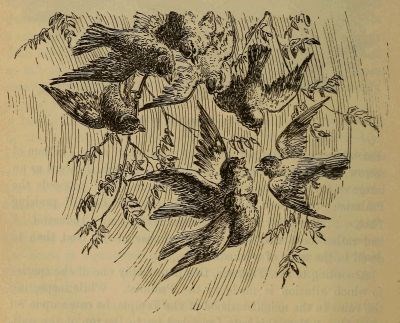

THE CUCKOO
The Cuckoo only twice mentioned in Scripture—The common species, and the Great Spotted Cuckoo—Depositing the egg.
Only in two instances is the word Cuckoo found in the Authorized Version of the Bible, and as they occur in parallel passages they are practically reduced to one. In Lev. xi. 16 we find it mentioned among the birds that might not be eaten, and the same prohibition is repeated in Deut. xiv. 15, the Jews being ordered to hold the bird in abomination.
It is rather remarkable that the Arabic name for the bird is exactly the same as ours, the peculiar cry having supplied the name. Its habit of laying its eggs in the nests of other birds is well known, together with the curious fact, that although so large a bird, measuring more than a foot in length, its egg is not larger than that of the little birds, such as the hedge-sparrow, robin, or redstart.






